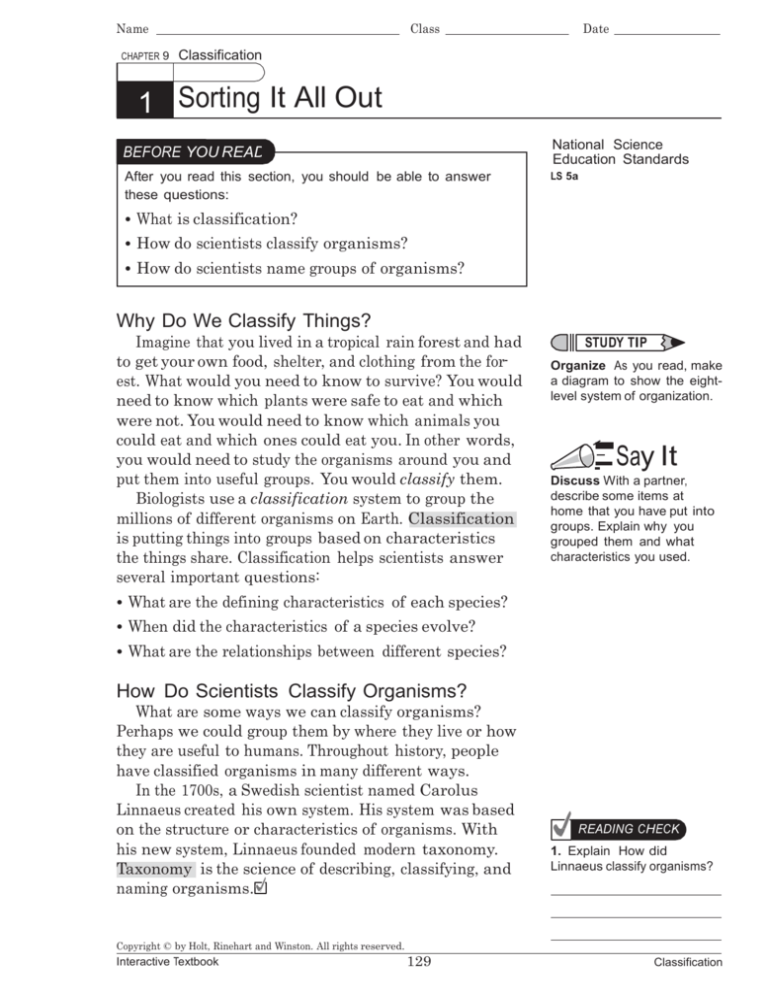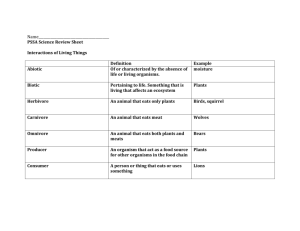
Name
CHAPTER 9
Class
Date
Classification
SECTION
1 Sorting It All Out
National Science
Education Standards
BEFORE YOU READ
After you read this section, you should be able to answer
these questions:
LS 5a
• What is classification?
• How do scientists classify organisms?
• How do scientists name groups of organisms?
Why Do We Classify Things?
Imagine that you lived in a tropical rain forest and had
to get your own food, shelter, and clothing from the forest. What would you need to know to survive? You would
need to know which plants were safe to eat and which
were not. You would need to know which animals you
could eat and which ones could eat you. In other words,
you would need to study the organisms around you and
put them into useful groups. You would classify them.
Biologists use a classification system to group the
millions of different organisms on Earth. Classification
is putting things into groups based on characteristics
the things share. Classification helps scientists answer
several important questions:
STUDY TIP
Organize As you read, make
a diagram to show the eightlevel system of organization.
Say It
Discuss With a partner,
describe some items at
home that you have put into
groups. Explain why you
grouped them and what
characteristics you used.
• What are the defining characteristics of each species?
• When did the characteristics of a species evolve?
• What are the relationships between different species?
How Do Scientists Classify Organisms?
What are some ways we can classify organisms?
Perhaps we could group them by where they live or how
they are useful to humans. Throughout history, people
have classified organisms in many different ways.
In the 1700s, a Swedish scientist named Carolus
Linnaeus created his own system. His system was based
on the structure or characteristics of organisms. With
his new system, Linnaeus founded modern taxonomy.
Taxonomy is the science of describing, classifying, and
naming organisms.
READING CHECK
1. Explain How did
Linnaeus classify organisms?
Copyright © by Holt, Rinehart and Winston. All rights reserved.
Interactive Textbook
129
Classification
Name
SECTION 1
Class
Date
Sorting It All Out continued
CLASSIFICATION TODAY
Critical Thinking
2. Infer What is the main
difference between organisms
that share many characteristics
and organisms that do not?
Taxonomists use an eight-level system to classify
living things based on shared characteristics. Scientists
also use shared characteristics to describe how closely
related living things are.
The more characteristics organisms share, the more
closely related they may be. For example, the platypus,
brown bear, lion, and house cat are thought to be related
because they share many characteristics. These animals
all have hair and mammary glands, so they are grouped
together as mammals. However, they can also be classified into more specific groups.
BRANCHING DIAGRAMS
READING CHECK
Shared characteristics can be shown in a branching
diagram. Each characteristic on the branching diagram
is shared by only the animals above it. The characteristics
found higher on the diagram evolved more recently than
the characteristics below them.
In the diagram below, all of the animals have hair and
mammary glands. However, only the brown bear, lion,
and house cat give birth to live young. More recent organisms are at the ends of branches high on the diagram. For
example, according to the diagram, the house cat evolved
more recently than the platypus.
3. Identify On a branching
diagram, where would you
see the characteristics that
evolved most recently?
Platypus
Brown bear
Lion
House cat
Ability
to purr
Retractable
claws
Giving birth to live young
TAKE A LOOK
evolved before the lion? Circle these organisms.
4. Identify According to the
diagram, which organisms
Copyright © by Holt, Rinehart and Winston. All rights reserved.
Interactive Textbook
130
Classification
Name
Class
Date
H
a
i
r
,
m
a
m
m
a
r
y
g
l
a
n
d
s
This branching diagram shows
the similarities and differences
between four kinds of
mammals. The bottom of the
diagram begins in the past,
and the tips of the branches
end in the present.
Copyright © by Holt, Rinehart and Winston. All rights reserved.
Interactive Textbook
131
Classification
Name
Class
SECTION 1
Date
Sorting It All Out continued
What Are the Levels of Classification?
Scientists use shared characteristics to group
organisms into eight levels of classification. At each level
of classification, there are fewer organisms than in the
level above. A domain is the largest, most general level of
classification. Every living thing is classified into one of
three domains.
Species is the smallest level of classification. A species
is a group of organisms that can mate and produce fertile
offspring. For example, dogs are all one species. They
can mate with one another and have fertile offspring. The
figure on the next page shows each of the eight levels of
classification.
TWO-PART NAMES
We usually call organisms by common names. For
example, “cat,” “dog,” and “human” are all common
names. However, people who speak a language other
than English have different names for a cat and dog.
Sometimes, organisms are even called by different names
in English. For example, cougar, mountain lion, and puma
are three names for the same animal!
Scientists need to be sure they are all talking about the
same organism. They give organisms scientific names.
Scientific names are the same in all languages. An
organism has only one scientific name.
Scientific names are based on the system created
by Linnaeus. He gave each kind of organism a two-part
name. The first part of the name is the genus, and the
second part is the species. All genus names begin with a
capital letter. All species names begin with a lowercase
letter. Both words in a scientific name are underlined or
italicized. For example, the scientific name for the Asian
elephant is Elephas maximus.
5. List What are two problems
with common names?
READING CHECK
6. Identify What are the two
parts of a scientific name?
Two-part
name
Genus:
Elephas
READING CHECK
species:
maximus
Copyright © by Holt, Rinehart and Winston. All rights reserved.
Interactive Textbook
132
Classification
Name
SECTION 1
Class
Date
Sorting It All Out continued
Levels of Classification of the House Cat
Kingdom Animalia: All animals are in the kingdom Animalia.
Phylum Chordata: All animals in the phylum Chordata have a hollow nerve cord.
Most have a backbone.
Class Mammalia: Animals in the class Mammalia have a backbone. They also
nurse their young.
Order Carnivora: Animals in the order Carnivora have a backbone and nurse their
young. They also have special teeth for tearing meat.
Family Felidae: Animals in the family Felidae are cats. They have a backbone,
nurse their young, have special teeth for tearing meat, and have retractable
claws.
TAKE A LOOK
7. Identify Which level
contains organisms that
are more closely related: a
phylum or a class?
Genus Felis: Animals in the genus Felis share traits with other animals in the
same family. However, these cats cannot roar; they can only purr.
8. Describe How does the
number of organisms change
from the level of kingdom to
the level of species?
Species Felis catus: The species Felis catus is the common house cat. The house
cat shares traits with all of the organisms in the levels above the species level,
but it also has unique traits.
Copyright © by Holt, Rinehart and Winston. All rights reserved.
Interactive Textbook
133
Classification
Name
Class
SECTION 1
Date
Sorting It All Out continued
What Is a Dichotomous Key?
What could you do if you found an organism that you
did not recognize? You could use a special guide called
a dichotomous key. A dichotomous key is set of paired
statements that give descriptions of organisms. These
statements let you rule out out certain species based on
characteristics of your specimen. There are many dichotomous keys for many different kinds of organisms. You
could even make your own!
In a dichotomous key, there are only two choices at
each step. To use the key, you start with the first pair of
Critical Thinking
9. Infer Why couldn’t one
single dichotomous key be
used for all of the organisms
on Earth?
statements.
You
choose
the
statement
from
describes the organism. At each step, the key may identhe organism or it may direct you to another pair of
statements. By working through the statements in order,
you can identify the organism.
the
pair
that
tify
Dichotomous Key to 10 Common
Mammals in the Eastern United States
1. a. This mammal flies. Its “hand” forms a wing.
b. This mammal does not fly. It’s “hand” does not
form a wing.
little brown bat
Go to step 2.
2. a. This mammal has no hair on its tail.
b. This mammal has hair on its tail.
Go to step 3.
Go to step 4.
3. a. This mammal has a short, naked tail.
b. This mammal has a long, naked tail.
eastern mole
Go to step 5.
4. a. This mammal has a black mask across its face.
b. This mammal does not have a black mask across
its face.
raccoon
Go to step 6.
5. a. This mammal has a tail that is flat and paddle shaped.
b. This mammal has a tail that is not flat or paddle
shaped.
beaver
opossum
6. a. This mammal is brown and has a white underbelly.
b. This mammal is not brown and does not have a
white underbelly.
Go to step 7.
Go to step 8.
7. a. This mammal has a long, furry tail that is black on
the tip.
b. This mammal has a long tail that has little fur.
longtail weasel
8. a. This mammal is black and has a narrow white
stripe on its forehead and broad white stripes on
its back.
b. This mammal is not black and does not have
white stripes.
striped skunk
9. a. This mammal has long ears and a short, cottony tail.
b. This mammal has short ears and a medium-length
tail.
eastern cottontail
woodchuck
white-footed mouse
Go to step 9.
TAKE A LOOK
10. Identify Use this dichotomous key to identify the
two animals shown.
Copyright © by Holt, Rinehart and Winston. All rights reserved.
Interactive Textbook
134
Classification
Name
Class
Date
Section 1 Review
NSES
LS 5a
SECTION VOCABULARY
classification the division of organisms into groups,
or classes, based on specific characteristics
dichotomous key an aid that is used to identify
organisms and that consists of the answers to
a series of questions
taxonomy the science of describing, naming,
and classifying organisms
1. List Give the eight levels of classification from the largest to the smallest.
2. Identify According to the branching diagram below, which characteristic do ferns
have that mosses do not?
Moss
Fern
Pine tree
Hibiscus
Flowers
Seeds
Tissues that transport materials
Ability to live on land
3. Analyze Which species in the diagram above is most similar to the hibiscus?
Which is the least similar?
4. Identify What are the two parts of a scientific name?
5. Infer Could you use the dichotomous key in this section to identify a species of
lizard? Explain your answer.
Life Science
Copyright © by Holt, Rinehart and Winston. All rights reserved.
Interactive Textbook
135
Classification








